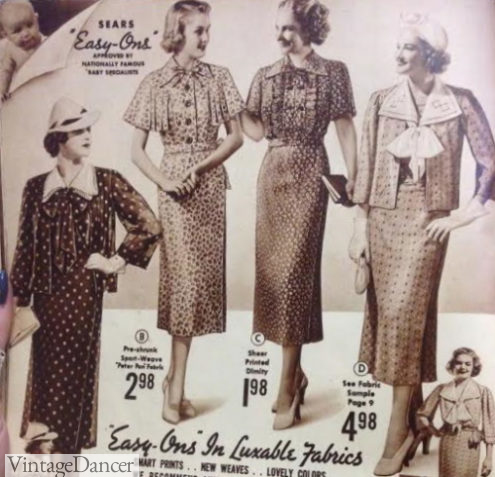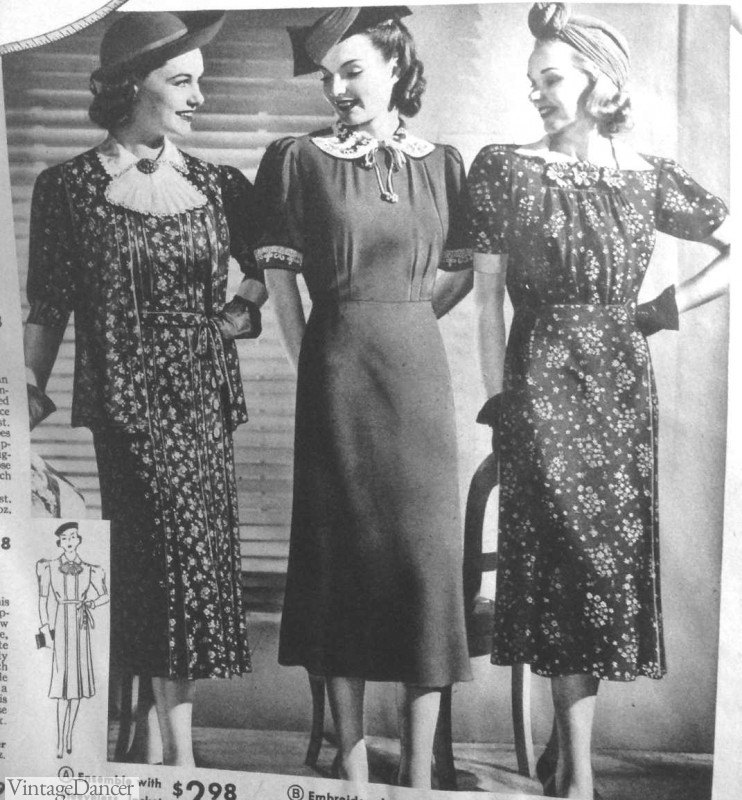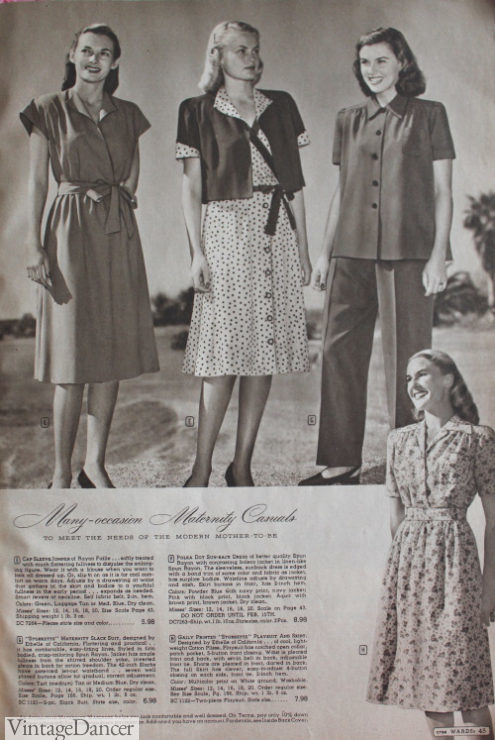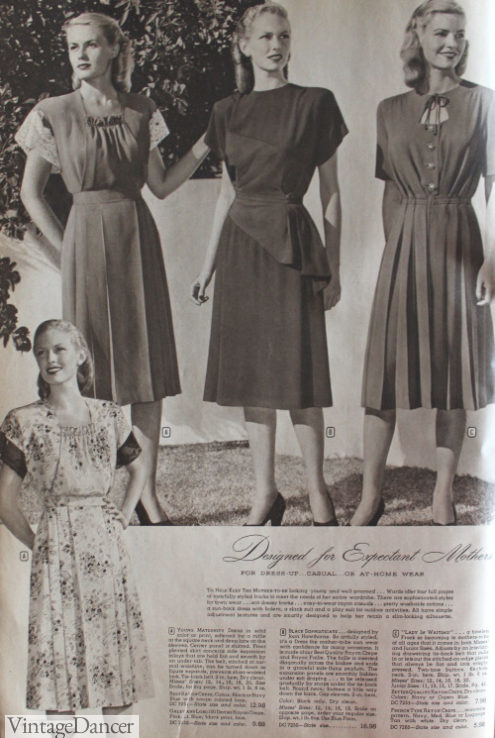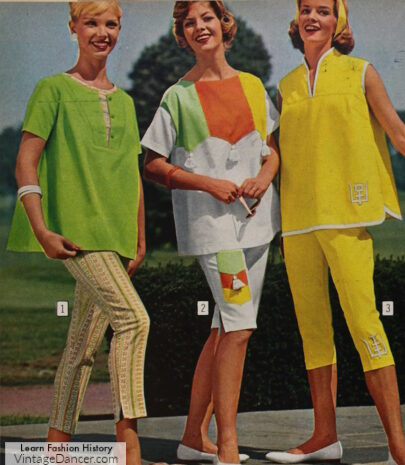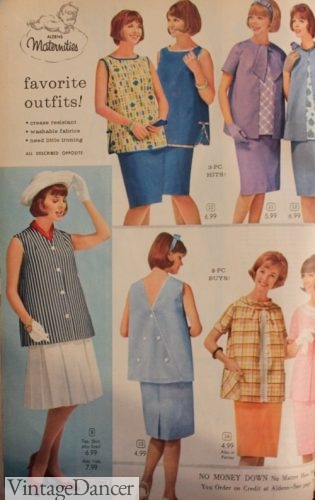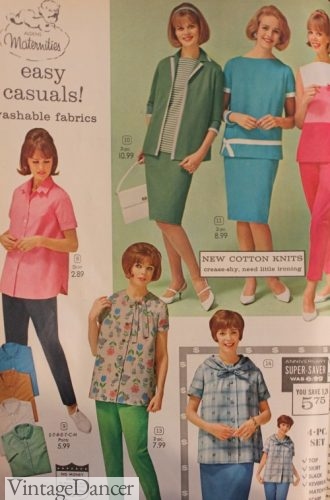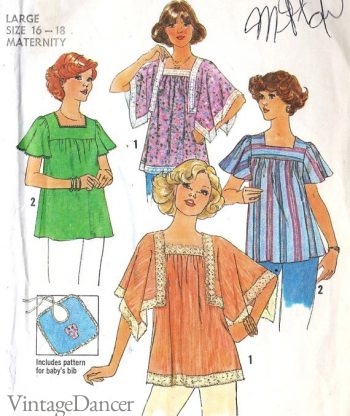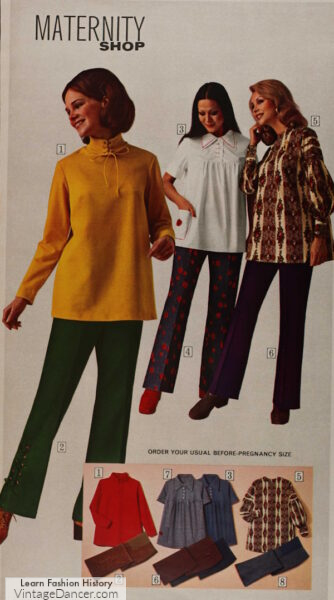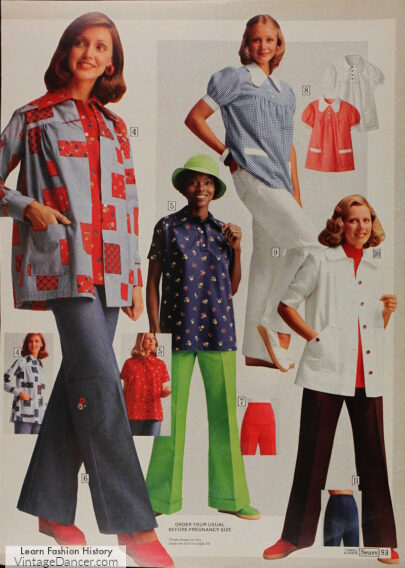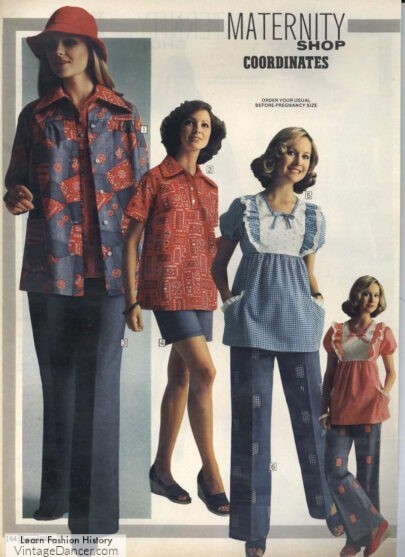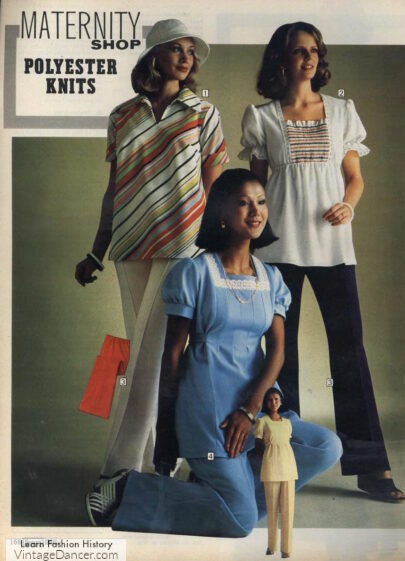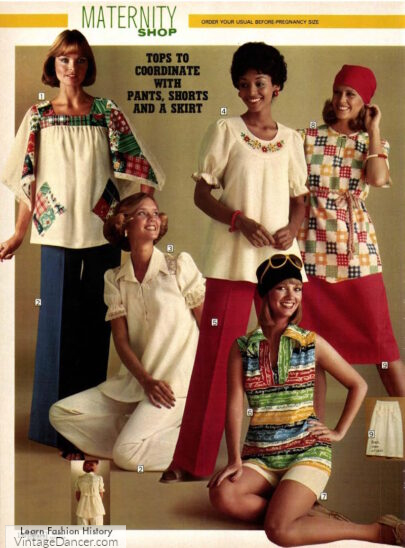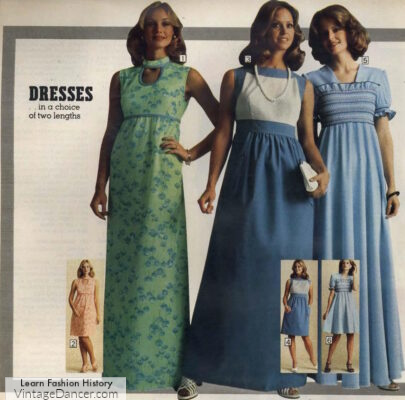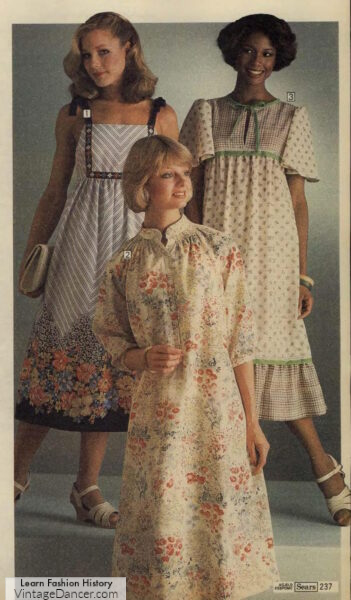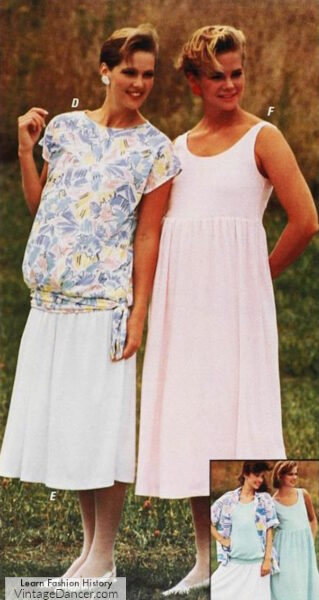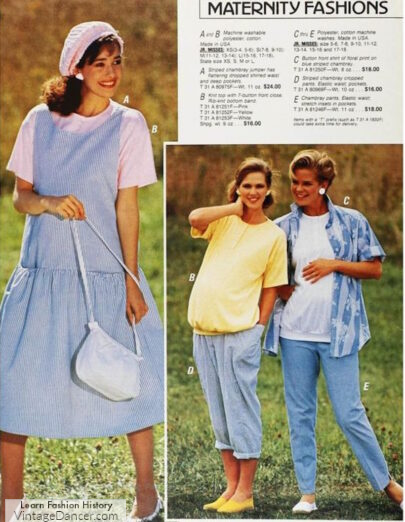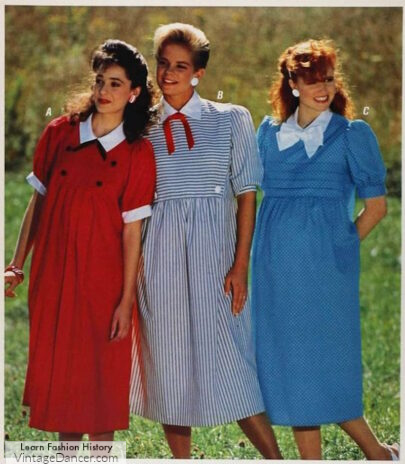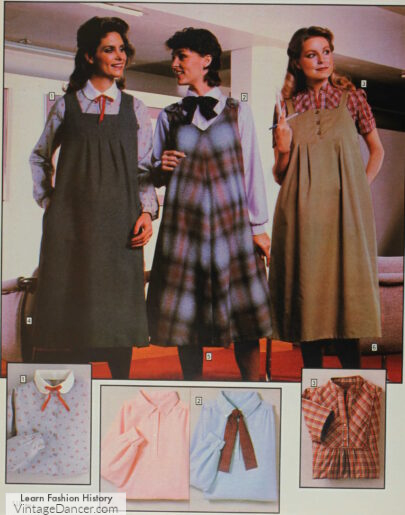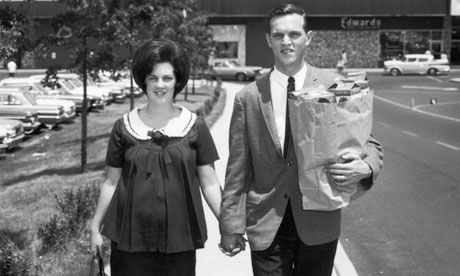
Adorable pullover smock top and skirt (1960s)
Having children is wonderful. Being pregnant, not so wonderful. Trying to dress vintage while being pregnant or nursing… challenging.
Vintage maternity clothes have a limited history. Being pregnant was a taboo subject, and nursing your own child was out of fashion by the 1950s (only 20% of mothers breast-fed their babies).
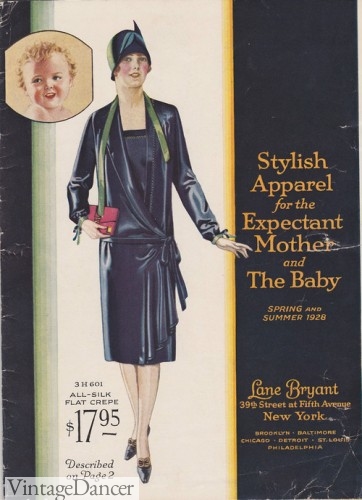
1928 Lane Bryant Maternity Clothes Catalog
As soon as a woman “showed” her pregnancy, she was expected to hide herself at home until after the baby was born and healthy enough to be out in public.
With limited maternity clothing made available for sale, it made the most sense to stay home in a comfortable house dresses until her figure returned to a shape worthy of public display. This sounds harsh, but it was the attitude for most of the 20th century.
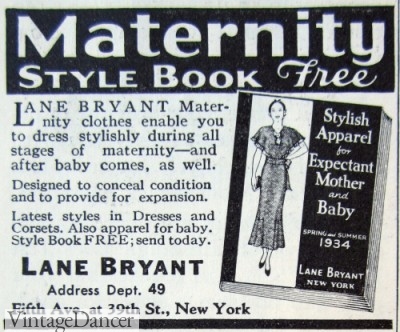
1934 Ad for Lane Bryant Maternity Clothing
Of all my clothing catalogs from 1890 to 1960, maternity clothing is limited to just 2 or 3 pages. Illustrations and photos never showed a woman with a bump until the late 1970s.
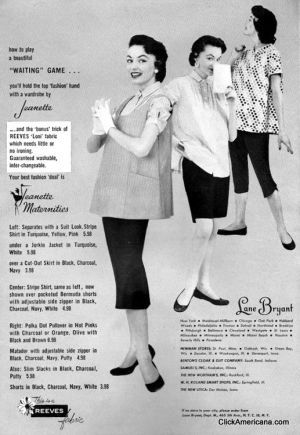
1950s Lane Bryant Maternity Clothes- Smock Tops and Pencil Skirts or Capri Pants
Lane Bryant had the only mail order clothing catalog to specifically cater to maternity wear. She had a very hard time even getting newspapers to print her advertisements for maternity clothing. She turned to catalogs and had better success. Soon other catalog companies copied her, and some department stores carried ready-made clothing and patterns (although women had to ask for them. They were not on display).
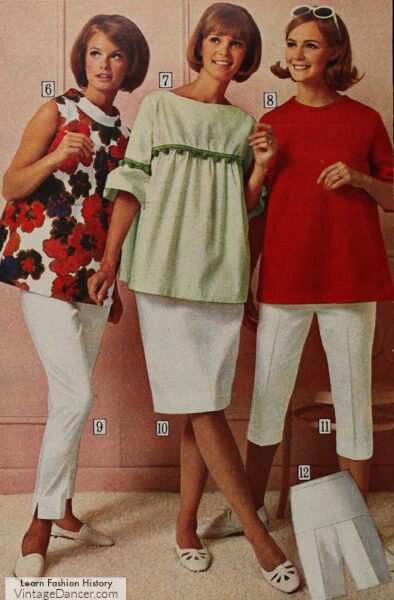
1967 maternity clothes sold by Sears
Today we will take a look at maternity clothing from the 1920s to the 1960s. Each decade had a similar but unique solution to hiding the baby bump and conquering the challenge of public breast-feeding.
For some more pictures of vintage maternity clothes, check out these articles here and here.
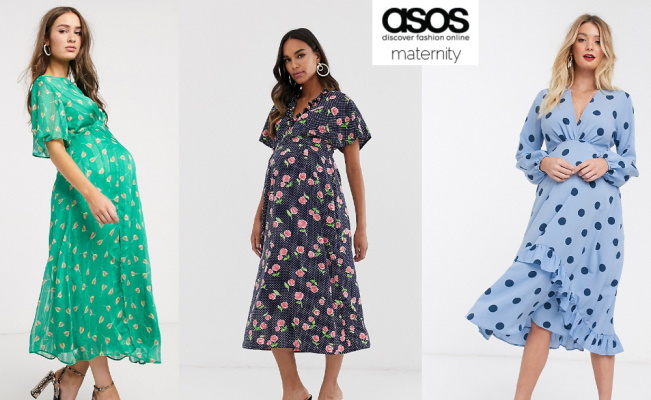
Shop maternity dresses, swimsuits, tops and bottoms at ASOS.
1920s Maternity Clothing
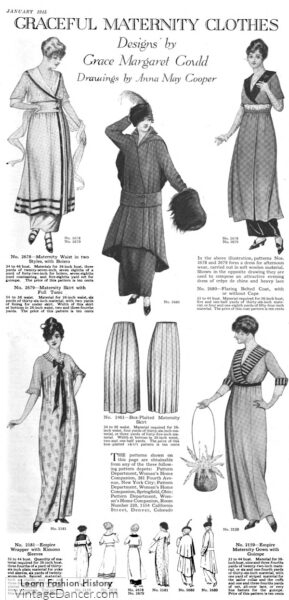
1915 maternity clothes with expandable waistlines
Luckily, 1920s loose fashions were perfect for maternity clothes. In the early years, a high belt at the natural waist was still popular, so maternity dresses featured elastic bands (top right dress).
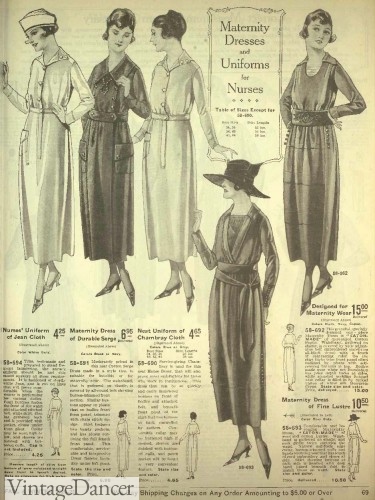
1921 Eaton’s Catalog of Maternity Dresses
Other styles had a tie belt that adjusted as the baby grew. In the mid and late ’20s, the slip dress with optional drop waist belt was in fashion which just moved the belt down below the belly (photo below). Not wearing a belt at all was the most flattering and forgiving 1920s maternity dress to wear.
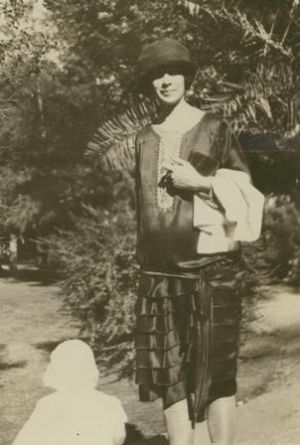
1920s Maternity Dress with Drop Waist Tie
There was also the wrap dress in the late 1920s, which was to become the staple maternity dress design for the next few decades.
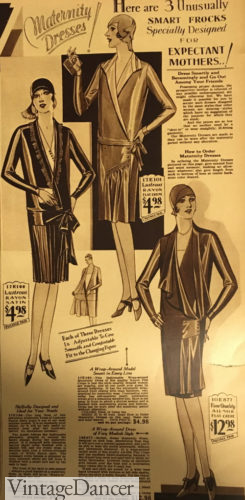
1929 maternity wrap dresses
For breastfeeding, a dress like the first picture, lower right, had a mock blouse attached with inside buttons. Unbuttoning the blouse from the dress provided access for breast-feeding. Since blouses were also loose-fitting, a blouse and skirt combination was an even more popular option. Lift and feed, moms!
One shocking thing about the “corset free” twenties is that women still wore them through pregnancy. Shocking that is until you read the fine print and a warning, “…abdominal compression is dangerous. A Maternity Corset that supports without binding, that is easily adjustable to the changing figure, gives freedom from pressure and protects both mother and child.”
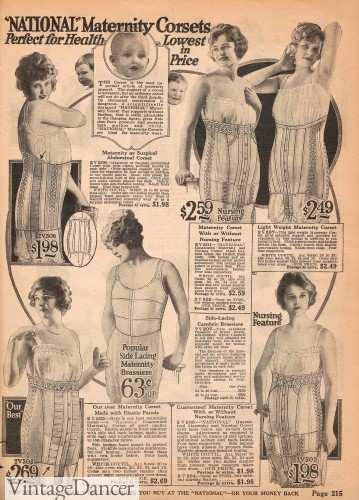
1922 Maternity Corsets
The maternity corset is vintage equivalent of a full-figured “belly band” that you can buy today (I used one, they do help aching backs!). The 1920s version was an underbust style so breast-feeding could still take place. Elastic panels and multiple lacing areas made adjusting easy. See, not so scary now : )
1930s Maternity Clothes
The 1930s fashion style was all about a feminine silhouette with a defined high waist. That was a problem for expanding waistlines. Designers now had to find ways to give pregnant women a waist that was also adjustable. It was also important to conceal pregnancy as long as possible.
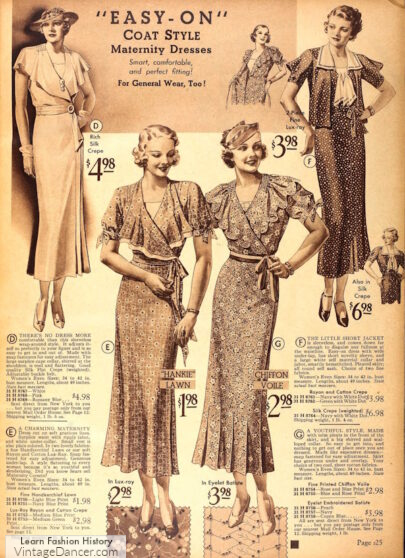
1934 coat style (or wrap) maternity dresses
Long capes, flounces, bolero jackets, and big bows that hung down from the neck and shoulders and over the belly were common features that hid fullness well. Small prints such as florals and polka dots also worked well as camouflage.
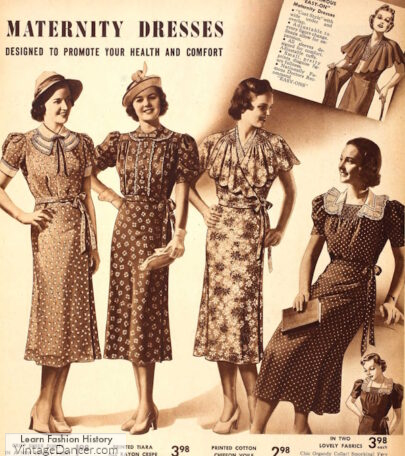
1938 hidden wrap style maternity dresses
With these miracle tricks, women could stay out in public longer before confinement to the home was expected.
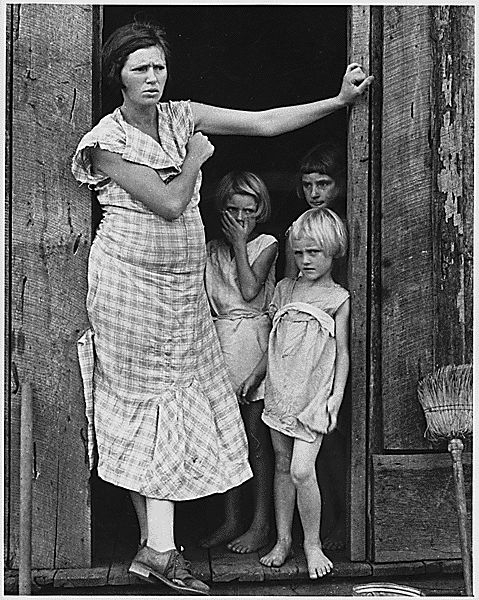
1935 pregnant sharecropper in a wrap top dress
For the waistline, a coat dress or wrap dress was very popular. One panel wrapped over the other and tied at the side.
A back wrap 1930s maternity dress was another option, where the wraps tied at the backside keeping the front smooth and trim.
Wrap slips were also a necessity under dresses. They were easy to put on, not requiring a woman to pull a dress over her head. The front wrap style was more casual than a back wrap.
- 1937 Easy On maternity dresses with wrap
- 1938 maternity dresses with side and back wraps
The 1930s two-piece skirt and top set was another option for women in the later years. The pattern above shows a wrap-around skirt with a matching pleated top. A belt could be worn with it to provide shape until she outgrew it. The loose button-down top also provided good access for breastfeeding.
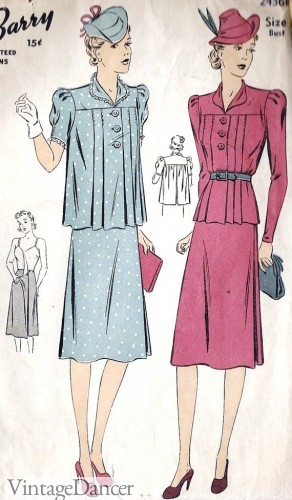
1930’s Maternity skirt and blouse pattern
1940s Maternity Clothes
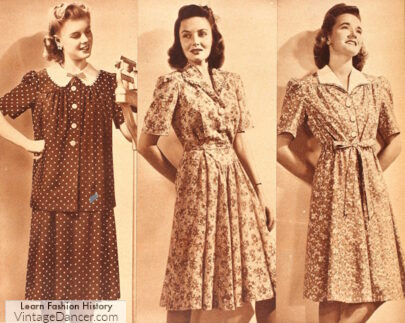
1943 maternity dresses, smock top and wrap styles
The 1940s saw similar dresses as the 1930s, especially in the early years, when WWII limited new designs (and also new families, although both my parents were born in the war years).
There were a few common 40s styles of maternity dresses. The 1930s favorite was the wrap front dress. One side of the dress wrapped over to the other size and was held in place with small buttons and a self fabric tie in the front.
As baby bumps grew, the wrap front moved closer to the center with a row of buttons on the side wrap. Extra fabric at the back of the dress also allowed room for expansion, but was kept neat by the tie.
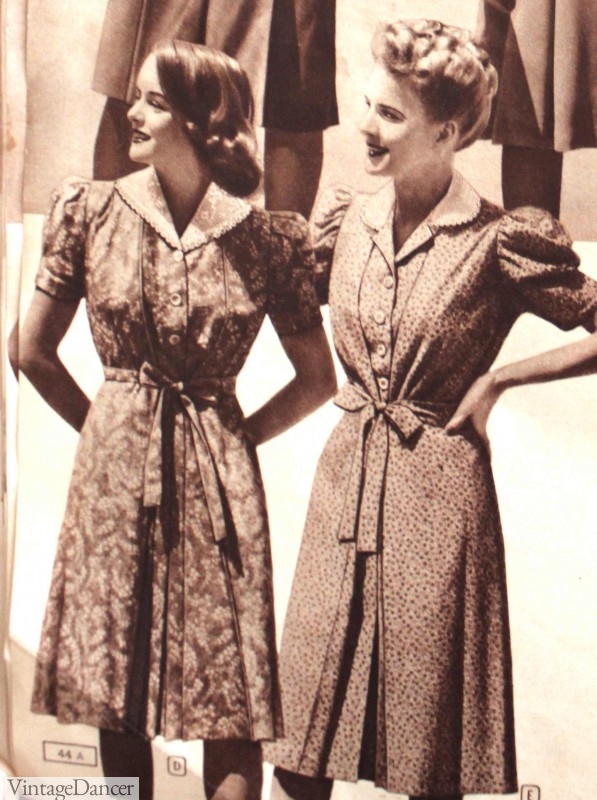
1943 Cotton Shirtwaist Maternity Dresses
The wrap front dress is a very common style for modern vintage maternity clothes too. Modern dresses are usually made of jersey, which makes breast-feeding easier than in the ’40s stiff cotton material. It was possible to unbutton and untie a wrap dress at home, but not very practical while out in public.
The shirtwaist dress was a better solution for public breastfeeding and was another popular 1940s maternity dress.
- 1947 maternity dresses
- 1947 maternity dresses
The shirtwaist buttoned either halfway or all the way down the front of the dress. It usually had a self fabric tie to the front or back as well. Just like the wrap dress, extra fabric with inverted pleats at the back provided enough material to grow. The front buttons made access to breastfeeding much easier, too.
Since catalogs didn’t photograph pregnant women, it is a little difficult to tell the difference between regular and maternity dress construction. Regular dresses had tailored seams in the bodice to create a defined shape. Maternity dresses lacked any tailoring. The shape was made by pulling in from the tie belt or buttons on side belts.
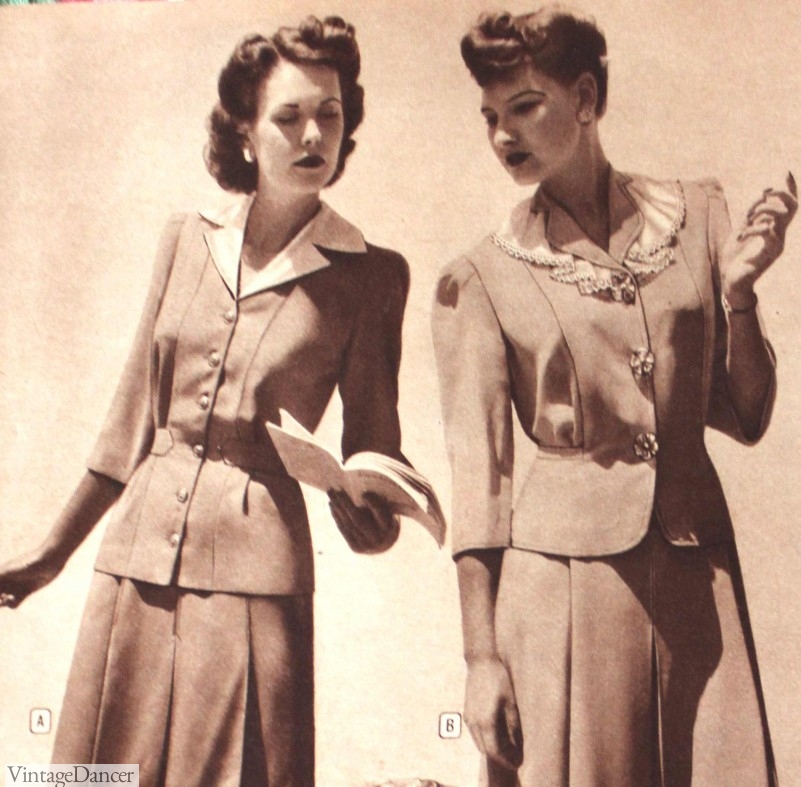
1943 Maternity Suits
Not all 1940s vintage maternity clothes were dresses. The skirt and jacket suit set was also adapted for maternity wear. The jacket buttoned down the front and had a half belt start at the side and fastened at the back, adjusting as necessary.
1940s maternity skirts had either a set of buttons that moved the skirt out or a drawstring waistband. Inverted back pleats were common in maternity skirts as well.
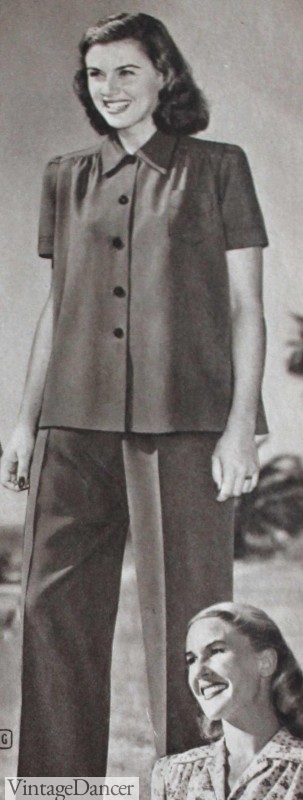
1947 Maternity Pant Playsuit
Pants were also another, newer, option for summer casual days. The pant playsuit was a rare but appreciated new style. The one on the right reads “Jacket has ample fullness from the shirred shoulder yoke, inverted pleats in back for action freedom. The 42 inch slacks have patented let-out waistband…seven well placed buttons allow for gradual, correct adjustment.”
At home, the smock top was designed to wear over dresses while cooking or doing dirty chores. They proved so popular among pregnant women as regular tops over skirts that by the end of the ’40s, they were a new maternity shirt style to wear.
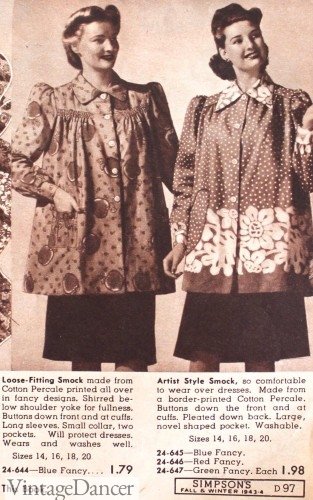
1940’s Maternity Smock Tops
1940s Maternity fashion Do’s and Dont’s:
- Do wear a cardigan, not a pullover shirt
- Do wear blouses with pleats at the shoulder and instead of bust darts
- Do let out dresses in the front as the baby grows
- Do wear a coat with long lines and and open front
- Add bigger accessories near the neckline (scarf, multi-strand necklaces)
- A smock top says “PREGNANT” while a dress is better at hiding the news
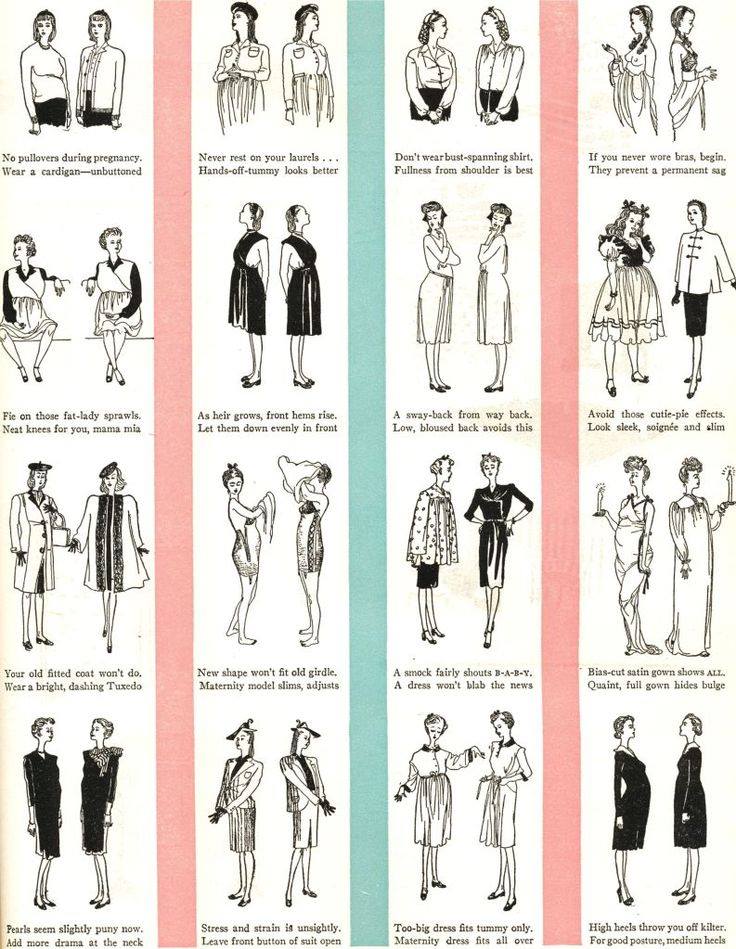
1940’s Maternity Fashion Do’s and Don’t
1950s Maternity Clothes
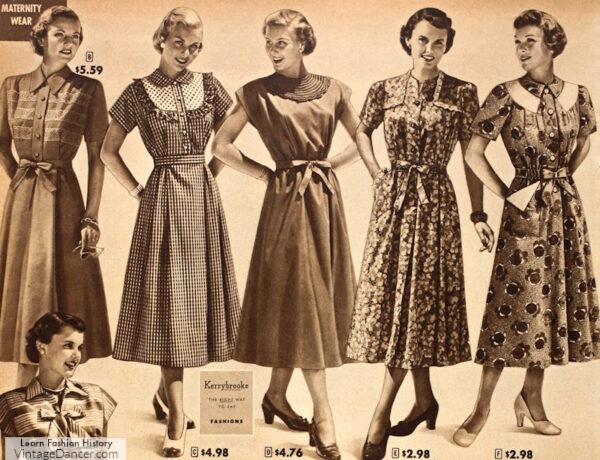
1950 maternity dresses
While the 1950s continued to produce both the wrap around and shirtwaist dress for maternity clothing, the two-piece separates were the big new fashion item. It was finally acceptable for women to not have a waistline in the 1950s.
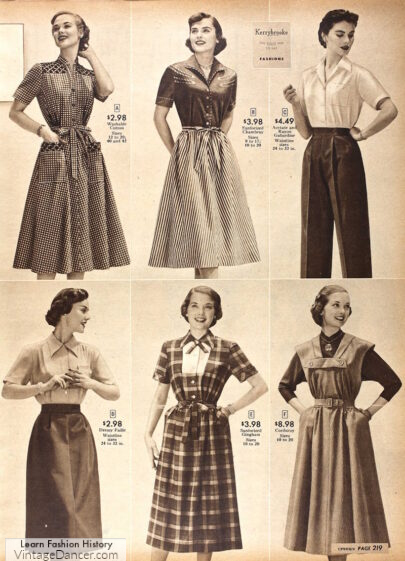
1953 maternity outfits
It was also more accepted to be out in public during the second and third trimesters. To fit the new social acceptance, women’s clothing adapted to a looser style.
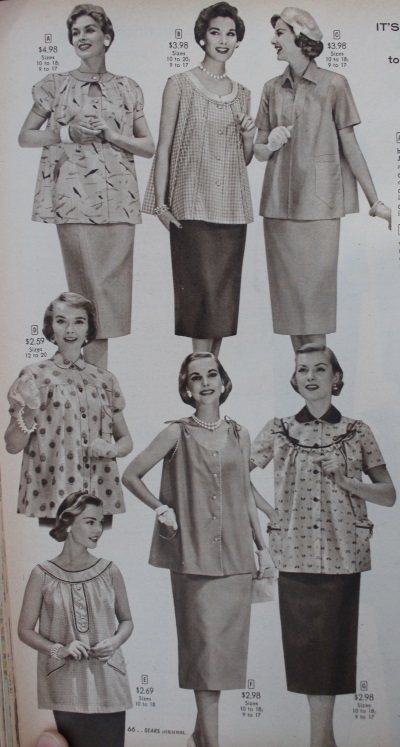
More smock tops and skirts. Too cute!
A wrap around style skirt could still be full circle or straight pencil shape (pencil being more popular). The front skirt line was an inch or two longer than the back. Each skirt could expand up to 10 inches.
There were also skirts made with a cut out in front. It was literally a round egg shaped piece missing from the front of the skirt. The top band tied in the front and a loose shirt hung over. A better skirt design was the zip-to-fit waistband.
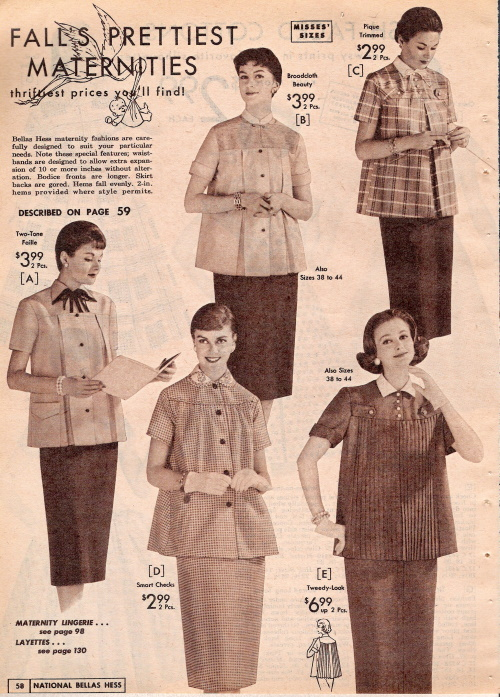
1957 Maternity Tops and Skirts
The loose pleated tops first seen in the 1930s combined with the smock apron top of the 1940s gave way to the button down shirts and coats of the ’50s. A loose blouse could be worn underneath a coat, or better yet a button down shirt.
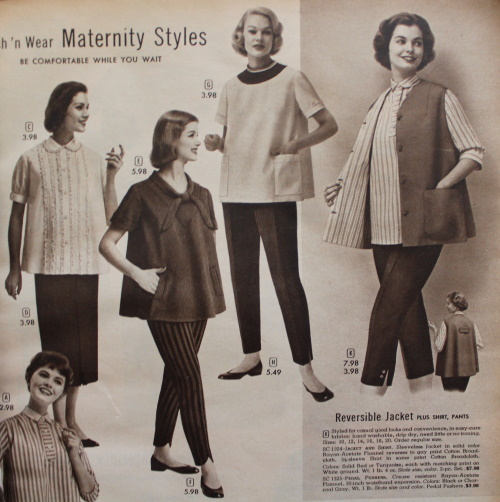
1957 Wards maternity casual pants and tops
Styled after men’s dress shirts, the button-down shirt could be worn tucked into skirts or untucked for a tent-like shape. The wide smock top over the slim skirt was a signature maternity style of the 1950s. It is also a style that is the most sought after in ’50s style maternity clothes (although not easy to find).
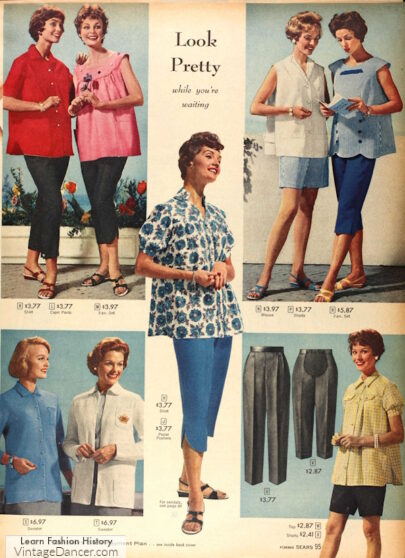
1959 tops, skirts, shorts and pants
Just like in the 1940s, pants also were being made in new styles for a pregnant woman. Now pants came in classic gabardine or denim crops with side adjustable tabs. Shorts were also available in summer.
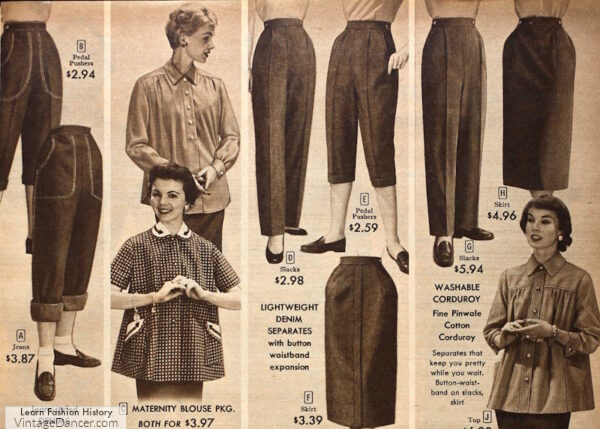
1955 maternity pants, shorts and jeans
1960s Vintage Maternity Clothes
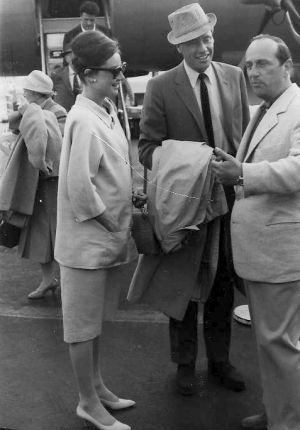
Audrey Hepburn in two-piece maternity suit
Maternity clothes from the 1960s continued with only stylistic changes from the 1950s to match current trends. Smock tops and button down skirts were still worn, although they were so loose that most of them were now pull over styles. Peasant style or “hippie” style tops also came in vogue by the end of the ’60s.
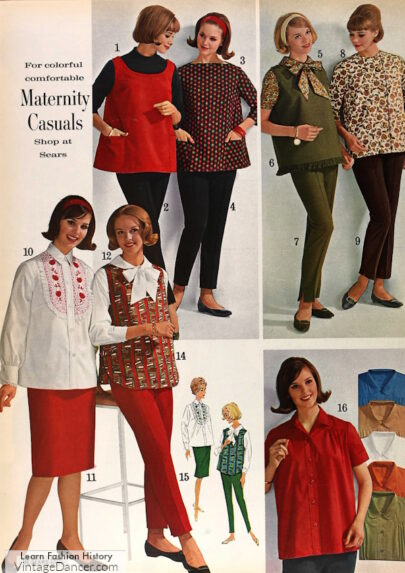
1963 maternity tops
Skirts were still wrap-around but were shorter overall. The famous “Twiggy” look was applied to maternity wear, too. Slim fitting sheath dresses created an easy A-line shape, perfect for a growing bump. They were loose but not baggy, and also did not adjust well. Women now needed to buy new clothes for each stage of their pregnancy.
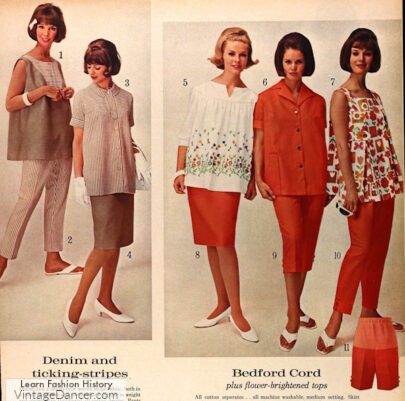
1964 pants, skirts and tops
There were less adjustable options that could be worn the entire pregnancy. This is still the trend today. I think I only had one clothing item I wore then entire 40 weeks of my pregnancy.
Pants and skirts in the ’60s were the first to feature a belly band similar to maternity pants today. The pants had an additional panel above the natural waistband with a draw string pull at the top. The pull tightened over the belly, reducing pressure off the mid belly.

1967 maternity clothes sold by Sears
1960s skirts also had these new belly bands, which made them look even slimmer on the bottom. A slightly longer, less trendy maternity top helped cover up these new bands.
- 1962 funky retro maternity clothes
- 1964 two piece maternity dresses
- 1964 casual maternity sets
- Late 1960s peasant maternity tops
1970s Retro Maternity Clothes
1970s maternity clothes resembled trendy fashion of the day more than previous decades. Smock tops were still preferred but were now paired with wide leg flares in polyester knits.
Long dresses became the latest style trends for pregnant women in the mid to late 1970s.
- 1972 maternity tops and pants
- 1975 maternity
- 1976 western maternity themes
- 1976 smock tops and pants
- 1977 tunic tops and pants
- 1976 maxi dresses
- 1979 soft maternity dresses
1980s Maternity Clothes
more info coming soon…
- 1987 tunic dress
- 1987 casuals
- 1987 Sailor theme
- 1983 jumper dresses
Where else to shop for vintage maternity?
I often find maternity clothes in vintage styles at these websites:
Vintage Maternity Dresses, Clothes, Sewing Patterns
Debbie Sessions has been teaching fashion history and helping people dress for vintage themed events since 2009. She has turned a hobby into VintageDancer.com with hundreds of well researched articles and hand picked links to vintage inspired clothing online. She aims to make dressing accurately (or not) an affordable option for all. Oh, and she dances too.
